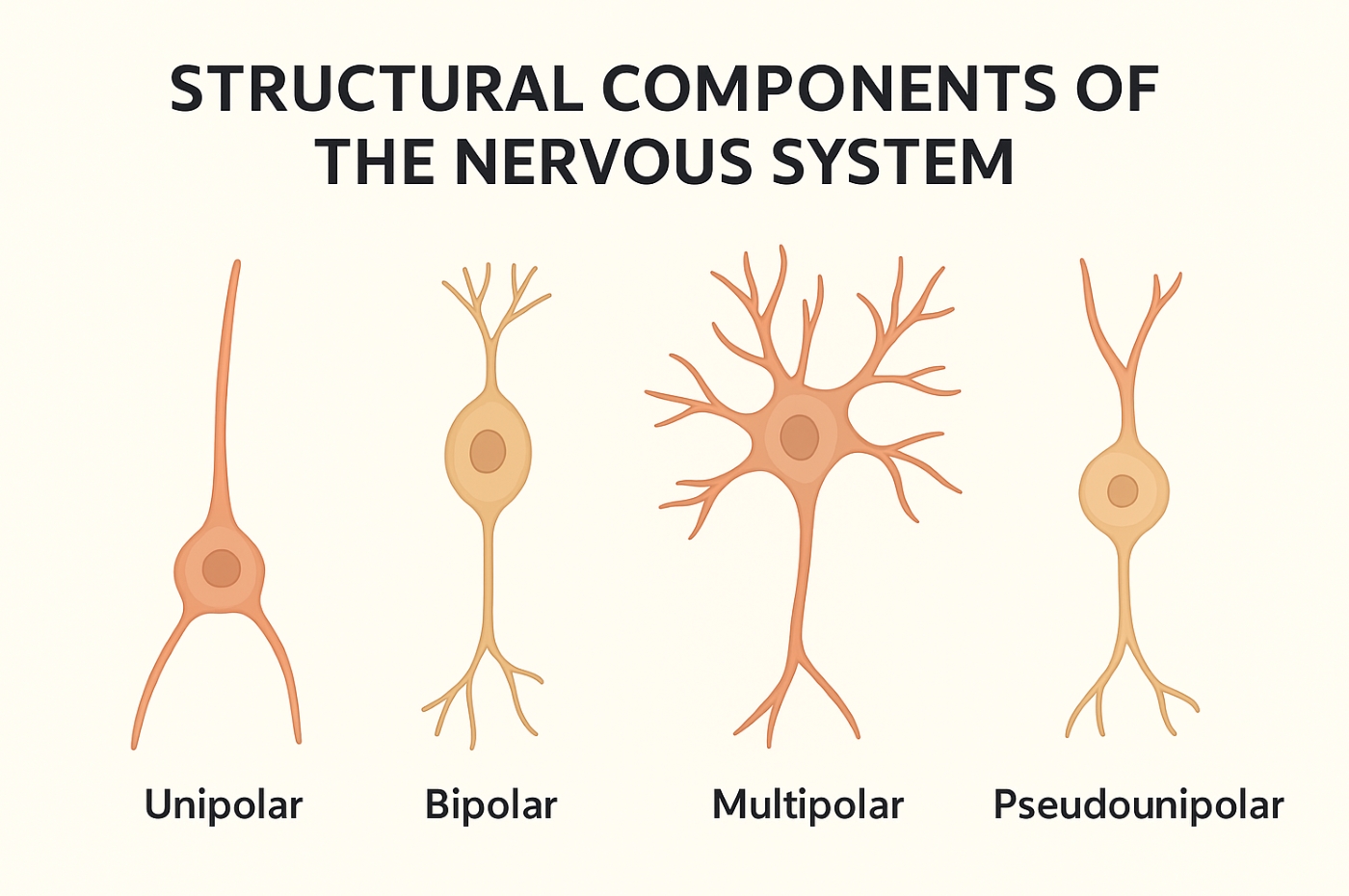Structural Components of the Nervous System: Understanding How Neurons Work
The nervous system is the body’s most intricate communication network. It controls everything — from reflexes and muscle movement to emotions and memory. Understanding the structural components of the nervous system helps medical students and healthcare professionals appreciate how electrical signals are transmitted throughout the body to maintain coordination and function.
🔬 What Makes Nerve Cells Unique?
Unlike other body cells, nerve cells (neurons) are highly specialized to conduct impulses. They have a distinctive structure and perform complex communication tasks that no other cell type can.
Here are some key characteristics that make nerve cells unique:
- No Centrosome: Neurons lack a centrosome, meaning they cannot divide or reproduce once damaged.
- Cytoplasmic Extensions: Their cytoplasm contains nerve fibers (axons and dendrites) for impulse transmission.
- Variety of Forms: Neurons are classified into unipolar, bipolar, multipolar, and pseudounipolar types based on their structure.
- Size and Shape Variation: They vary greatly in size, shape, and arrangement of processes.
- Sensory Neurons: Bipolar and pseudounipolar cells act as receptor neurons, receiving stimuli from sensory organs.
- Motor and Interneuron Cells: These are multipolar in nature and responsible for transmitting signals to muscles and glands.
- Monopolar Cells: True monopolar neurons are seen only in lower vertebrates and fetal stages.
- No Neurilemma in CNS: Central nervous system (CNS) fibers lack neurilemma, preventing regeneration after injury — one reason why spinal cord damage is often permanent.
🧩 Types of Neurons and Their Functions
1. Receptor (Sensory) Neurons
- Found in the retina, auditory system, and sensory ganglia of cranial nerves.
- Typically bipolar or pseudounipolar in structure.
- Have two processes:
- Peripheral process: Carries impulses from sensory receptors to the CNS.
- Central process: Connects to the spinal cord or brain, forming synapses with interneurons.
- These neurons form the afferent pathway, transmitting sensory information like touch, sound, and light.
2. Motor Neurons
- Multipolar neurons located in the cranial and spinal nerve nuclei.
- Their cell bodies and dendrites form synapses with sensory and interneurons.
- Axons exit the CNS via the motor roots to stimulate muscles or glands.
- This pathway is called the final common motor pathway, as all motor impulses pass through it before reaching the target organ.
3. Interneurons (Association Neurons)
- Found within the brain and spinal cord.
- Act as connectors between sensory and motor neurons, ensuring efficient information processing and reflex control.
⚡ Nerve Fibers and Synaptic Connections
Nerve fibers are the long extensions (axons) that carry signals between neurons. They may be:
- Myelinated fibers: Covered with a myelin sheath that increases transmission speed.
- Unmyelinated fibers: Slower in conduction but crucial in areas where rapid response is not essential.
In the CNS, myelinated fibers lack neurilemma, which makes repair after damage difficult. Neurons communicate through synapses, where electrical or chemical signals are transferred from one neuron to another, ensuring seamless communication throughout the nervous system.
🧠 Clinical Insight
Damage to nerve fibers in the CNS — such as in spinal cord injuries or strokes — is often irreversible because of the absence of neurilemma. In contrast, peripheral nerves can sometimes regenerate if the neurilemma sheath remains intact, allowing partial recovery of function.
🩸 Conclusion
The structural components of the nervous system form the foundation of human neurophysiology. From the specialized shape of neurons to the complex network of synapses, each element plays a crucial role in maintaining communication between the brain, spinal cord, and the rest of the body. Understanding this structure is essential for diagnosing and treating neurological disorders effectively.
🧾 Key Takeaways
- Nerve cells are highly specialized and non-replicative.
- Sensory neurons carry information to the CNS, while motor neurons send commands from the CNS to effectors.
- The CNS lacks neurilemma, limiting its ability to regenerate after injury.
- Synapses are vital for transmitting signals and coordinating body functions.
(FAQ Section)
The main structural components of the nervous system include neurons (nerve cells), nerve fibers, synapses, and supporting cells (neuroglia). These elements work together to transmit electrical impulses throughout the brain, spinal cord, and peripheral nerves.
There are four main types of neurons based on their structure:
Unipolar neurons
Bipolar neurons
Multipolar neurons
Pseudounipolar neurons
Each type has distinct functions, such as sensory reception, motor control, or interneuronal communication.
● Sensory neurons (afferent) carry impulses from sensory organs to the CNS.
● Motor neurons (efferent) transmit commands from the CNS to muscles or glands to produce movement or secretion.
Neurons in the CNS lack a neurilemma sheath, which is essential for nerve regeneration. Without this protective covering, damaged nerve fibers in the brain and spinal cord cannot regrow, leading to permanent loss of function in many cases.
The final common motor pathway refers to the route through which all motor impulses leave the CNS to reach muscles. It consists of the axons of motor neurons, which connect directly to muscle fibers to produce movement.

